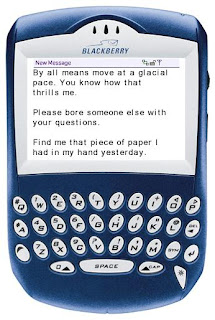As I mentioned in my previous post, I attended a Microsoft event to demonstrate Vista and Office 2007 last Wednesday. I also mentioned that there was a technical snafu that caused the event to start a half hour late.
This seemed like the perfect opportunity to get the inside scoop from a professional speaker who travels around the country using and demonstrating technology as a core piece of his presentation. I interviewed Jeff Lowe, a Microsoft Solutions Specialist who gave the presentation, and asked him some questions about dealing with technology issues when traveling for speaking engagements.
Do you mind sharing the details of what happened yesterday at the MS presentation in Santa Barbara? It was mentioned that you left your laptop behind, and I'd like to know what steps were taken to get your presentation to you and new equipment hooked up. When did you realize you didn't have it, and what had to happen in order for the presentation to occur?First all, in all my years of traveling for the technology industry yesterday was the first time I left home without my laptop. I have traveled since 1997. It just so happened that it was for the Santa Barbara event. So what you saw yesterday was the exception and not the norm. I just plain forgot it. Busy day with sick kids, errands, etc. was running late for the airport and failed to put it in my bag.
I realized that I didn’t have my laptop the night before when I got the airport. I picked up my bag and realized it was extremely light. I looked inside and no laptop. I called my wife to bring it to me but she could not make it to the airport in enough time.
After that, I called the guys from [the companies hosting the presentation in Santa Barbara], letting them know I would need a PC to lead the presentation. They had the proper PC and all I had to do was insert my portable hard drive.
The problem occurred when I wasn't allowed to test the laptop that was provided. I didn't insist that they let me check it, which I normally do. The laptop was an IBM widescreen model. The widescreen wasn't compatible with the type of projector provided by the hotel.
Widescreen can provide some big compatibility issues as it requires the projector to communicate at another level of frequency and screen resolution.
Tip for presenters – be nice and insist on checking that the projector works with your computer, even if you have get a little testy with the technical folks.
What percentage of your presentations have some sort of snafu like this? What's the most common problem you run into on the road?Very few of my presentations have snafus like this. Of all the events I have done in the last year, only two, the event yesterday and an event in Raleigh NC had this type of issue.
In Raleigh, we just pulled out another projector and got going right away. I have probably done about 50+ events since March of last year. So this makes the percentage fairly small, 4%. We also contract with a professional AV company that handles most of these things for us for certain events. This really minimizes the risk of yesterday's occurrence.
The most common problem I run into is old hardware, mostly projectors. A lot of places have older equipment. The newer laptops with high resolutions, wider screens and newer software expose the age of the equipment. Also, many of them aren't designed to support the new high resolution graphics capabilities that come with the latest and greatest graphics cards and operating system software.
If you look across 10 years and all the presentations I have ever done, the fraction would be less than 1% because of the 100's of presentations I have done without leaving my laptop at home.
What is your Plan B, Plan C, and so on for when things like this happen?Plan B was when I arrived. I carry a back-up hard drive that has all the information and data I need to deliver a presentation. I installed all the back up information on the back up PC. Once the back up PC failed, I did the same with the next PC that was provided. Worse case scenario, there were 300 copies of the presentation already copied and ready to be passed out. We never got there.
Do you have any special tips, tricks or advice to offer other speakers when dealing with technology as part of their presentations - especially when traveling for speaking engagements? The best thing is to NOT tell the crowd what started the problem. It was very unprofessional of the staff yesterday to say I was having a problem without first consulting me.
I always act like I know what I am doing even when things are going wrong. If you don’t have to tell the audience you are having problems, don't – they won't know the difference.
For example, a hard drive had crashed leaving me without a demonstration drive. I delivered the presentation as if everything was working fine. The audience didn't know the difference and thought I provided one of the best presentations they had ever seen.
Confidence is 90%. The last 10% is having all the pieces in place to execute as if it were plan A.
Thank you for taking the time to answer my questions, Jeff!
____________________________________________________
On The Everything Page you'll find everything you need to build visibility, credibility and influence through engaging presentations that move your participants into action: freebies, low-cost products and courses, and 1:1 coaching!







